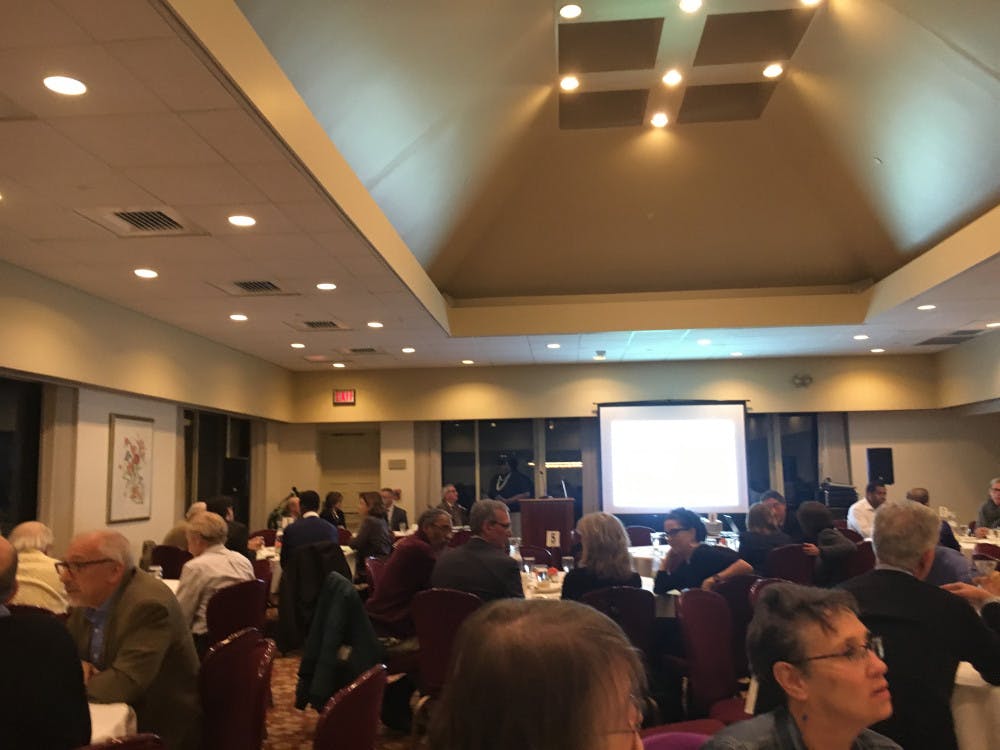Tuesday’s faculty meeting featured a motion that would allow faculty to reduce their teaching load below one course per semester under special conditions and a discussion of the University’s response to House Republicans’ proposed tax code.
The motion, which was approved by a faculty vote, was introduced by Timothy Herbert, professor of oceanography. It amends the faculty rules to permit active, “in residence” professors to “course bunch,” meaning they can condense the number of courses required by their respective departments per year into one semester, Herbert said.
The change comes as part of a joint initiative between Dean of Faculty Kevin McLaughlin and the Faculty Executive Committee to find new ways to support faculty in their research. Targeted at “large and complex projects,” course bunching is meant to be employed only in “exceptional” cases and during the preparatory or first-year period of any given research endeavor, Herbert said. To receive permission to teach zero classes during a semester in residence, faculty must go through the department chair, vice president of research and dean of faculty. If granted approval, professors are expected to attend to all other duties of active faculty, such as advising, Herbert said.
“I think it’s a good thing,” Senior Associate Dean of Faculty and Professor of Engineering Janet Blume told The Herald. “The care is taken to make sure that in doing this, faculty will be present and on campus for advising when their teaching load is shifted around from one semester to another.”
Some universities allow any professor to course bunch, but this motion does not give blanket permission, Herbert said.
Faculty raised concerns that this change was only applicable to professors in STEM. Herbert responded by assuring that other aspects of the research-directed initiative will focus on faculty in the humanities and social sciences, which will be discussed in future meetings. One of these proposed initiatives is the “top-up” sabbatical, which guarantees full pay during a full year of sabbatical, McLaughlin said. Currently, sabbaticals do not guarantee a year of full pay.
The benefits of course bunching include “the recognition of leadership in areas of scholarship that comes along with being the lead institution on large, complex proposals,” Herbert said.
Later in the meeting, Provost Richard Locke P’18.5 stressed the ramifications of the tax bill working its way through Congress this week. He touched on several provisions in the bill that have the potential to negatively affect the University, including a proposed 1.4 percent excise tax on net investment income on private institutions with endowments of at least $250,000 per full-time student and at least 500 full-time students. This proposal affects 68 institutions, of which the University is one.
“We don’t know the full scope of this, but it’s actually a real issue for us to be concerned about,” he said.
Locke also highlighted other provisions that target students, such as repealing the student loan interest deduction and the impact of eliminating certain clauses in the current tax code which permit educational institutions to provide their employees, spouses and dependents with tuition reductions that are excluded from taxable income.
“We are working closely with Ivy Plus colleagues and our different associations … to basically identify objectionable provisions and to determine their impact and to develop a coordinated strategic plan to defeat these provisions,” he said.
The University has formed an “ad hoc tax group” as a branch of the Government Relations Working Group that was developed earlier this year, Locke said. The tax group, made up of “key administrators,” is working with the congressional delegation and staff in Washington, D.C. They are directing advocacy efforts on leadership in the House and Senate, with a particular focus on the House Committee on Ways and Means and the Senate Finance Committee, Locke added.
The meeting also featured President Christina Paxson’s P’19 report on the corporation meeting and BrownTogether campaign. The BrownTogether campaign is on target to reach its goal by 2022.
“I hope we can do better and either end early or go above our goal,” Paxson said.
The meeting concluded with a presentation from Vice President for Research Jill Pipher on the University’s research initiatives, which stressed the importance of expanding infrastructure to grow research in certain areas, and a round table discussion on Title IX led by Title IX Program Officer Rene Davis. Faculty were asked to consider a scenario in which an undergraduate student who identifies as transgender shared concerns about a professor with their academic advisor.





